There are around six thousand species of coral in the world, so picking the right one for your reef aquarium might seem a bit daunting!
To make it easier for you, we’ve compiled a list of some of the best species for beginner to intermediate reef tank owners to look after.
But before we get into that, let’s understand the difference between the two main types of coral.
The Difference Between Soft Corals and Hard Corals
Although there are many ways to classify the different types of corals, we can broadly divide them into two groups: soft corals and hard corals.
Soft Corals

Soft corals are so-called because, well, they’re softer than hard corals!
Because they have no exoskeleton, these types of corals are less rigid and are capable of moving in a current. You’ve probably seen them swaying in the flow of the water current. Many aquarists find this swaying motion highly attractive or even hypnotic.
The great news is that several soft corals are some of the easiest types of coral to keep! Although each subgroup of soft corals has its own requirements, many species are ideal for newcomers to the coral reef tank hobby.
Hard Corals

Hard corals earn their name from their hard exoskeletons made from calcium carbonate – the same basic compound that constitutes the shells of shellfish, as well as limestone and chalk. It’s not surprising then, that hard coral structures can resemble rocks when they die.
Because of their rigid structure, hard corals don’t move and sway in the current as soft corals do, and they also grow more slowly. In themselves, hard corals don’t tend to be very colorful, but inherit their color from the different kinds of algae that grow on them.
Hard corals can be further divided into different types, with two of the main branches being ‘small polyp stony’ (SPS) and ‘large polyp stony’ (LPS). LPS corals tend to be much easier to grow than SPS corals, but as a general rule, hard corals are significantly more difficult to keep than soft corals.
Types of Soft Coral
Mushroom Corals
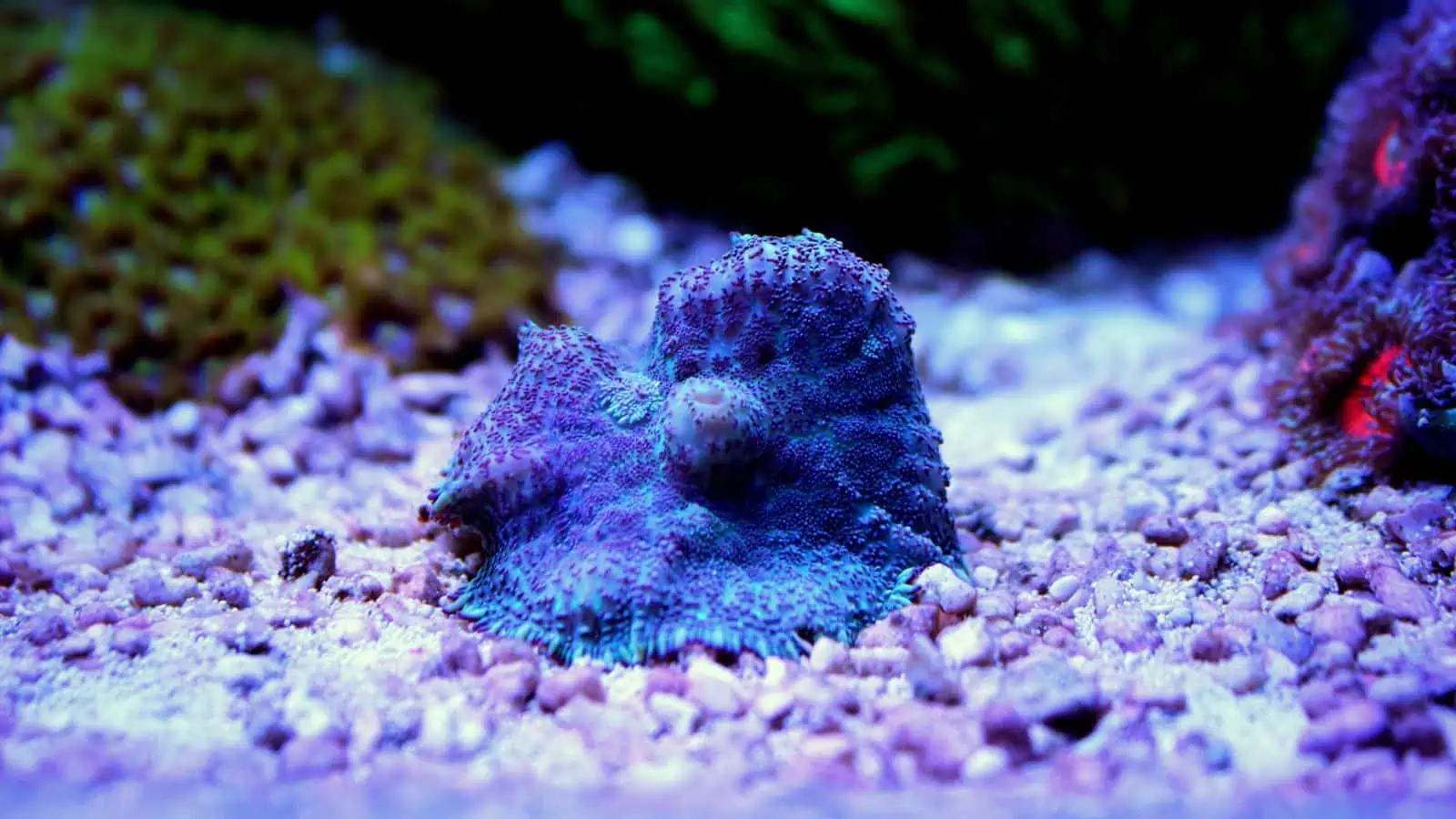
Mushroom corals are a family of soft corals that are among the easiest types of corals to care for.
Because they have low light requirements and don’t need a strong flow of water, super high water quality, or direct feeding, they make one of the best families of corals for beginners.
But just because they’re easy, that doesn’t mean that mushroom corals are not highly desirable. Whereas some mushroom corals like ‘bounce mushrooms’ are easy to keep but not highly prized, discosoma mushroom corals like jawbreakers and eclectus discosoma can sell for thousands.
The three most popular types of mushroom corals are Discosoma, Ricordea, and Rhodactis.
Some mushroom corals have a reputation for being invasive and overcoming weaker corals, so take great care when mixing them with other types of corals in your tank.
Green Star Polyps Coral

Green star polyps are so popular that they’ve even earned their own abbreviation: GSP.
These corals are so hardy that they can survive in almost any situation. They’re unfussy with regard to lighting and water flow, and have a lovely way of swaying about that immediately conjures up feelings of being in a real tropical reef.
While they’ll generally gather enough energy from light sources to keep them happy, they’ll grow even faster when given additional target feeding.
It must be noted, though, that green star polyps can spread quite aggressively and can take over rocks, aquarium glass, and other coral species! In every other way, they’re eminently suitable for beginners.
Pulsing Xenia Coral
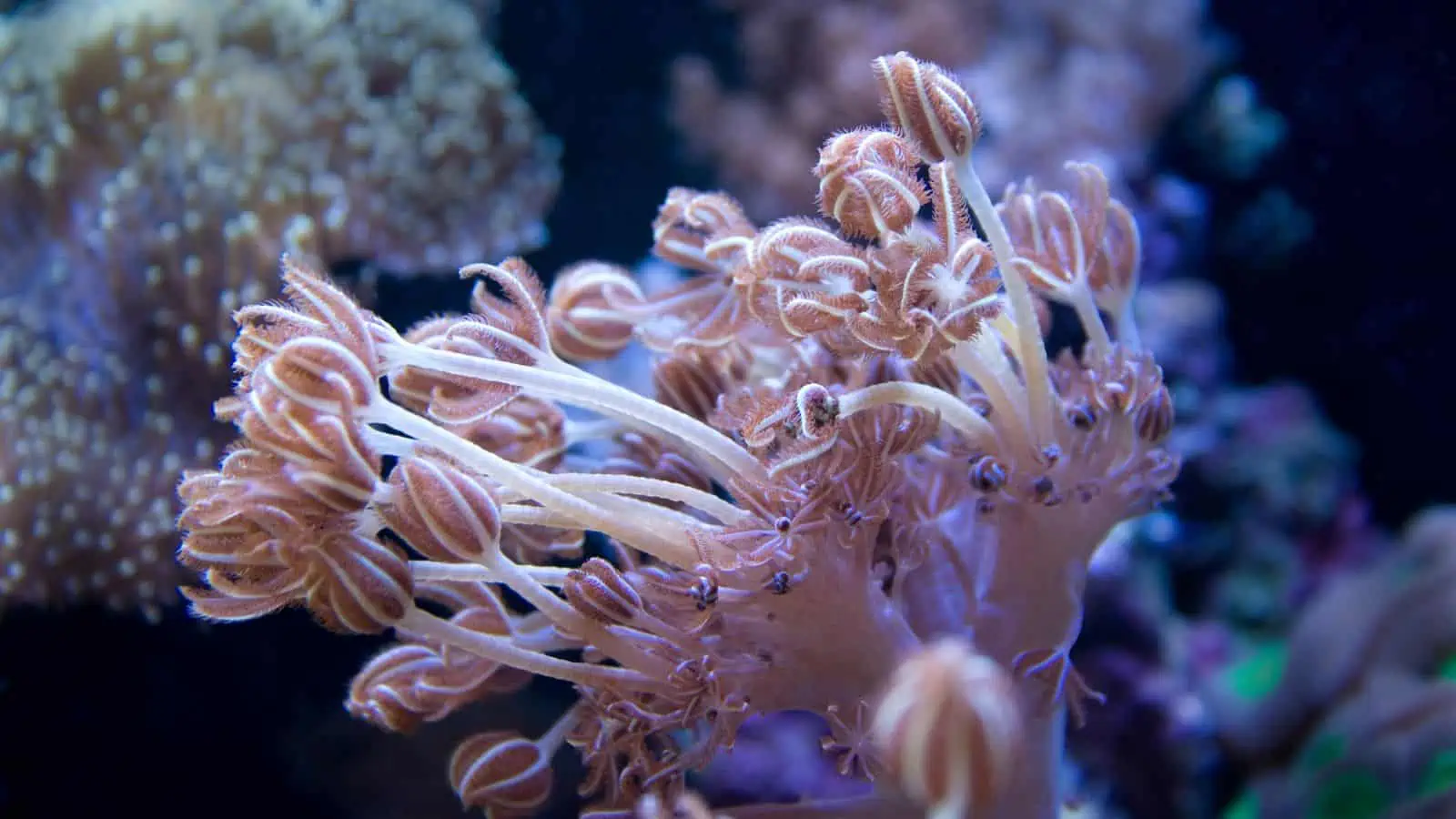
Pulsing xenia is another excellent choice for first-time reef keepers. They get their name from the way their polyps open and close independently of water flow, creating an attractive pulsing motion.
Also known as ‘waving hand coral’, they’re closely related to the very similar Anthelia corals. While they’re slightly more picky than green star polyps, xenia are still one of the hardiest corals and usually grow robustly.
As with green star polyps, their rate of growth can become a downside. If they decide they like your tank, they might try to grow all over it, smothering everything else including other corals. Keeping them on an island or adjacent to more aggressive corals is a good way to keep their growth in check.
Kenya Tree Coral (AKA. Cauliflower Soft Coral)
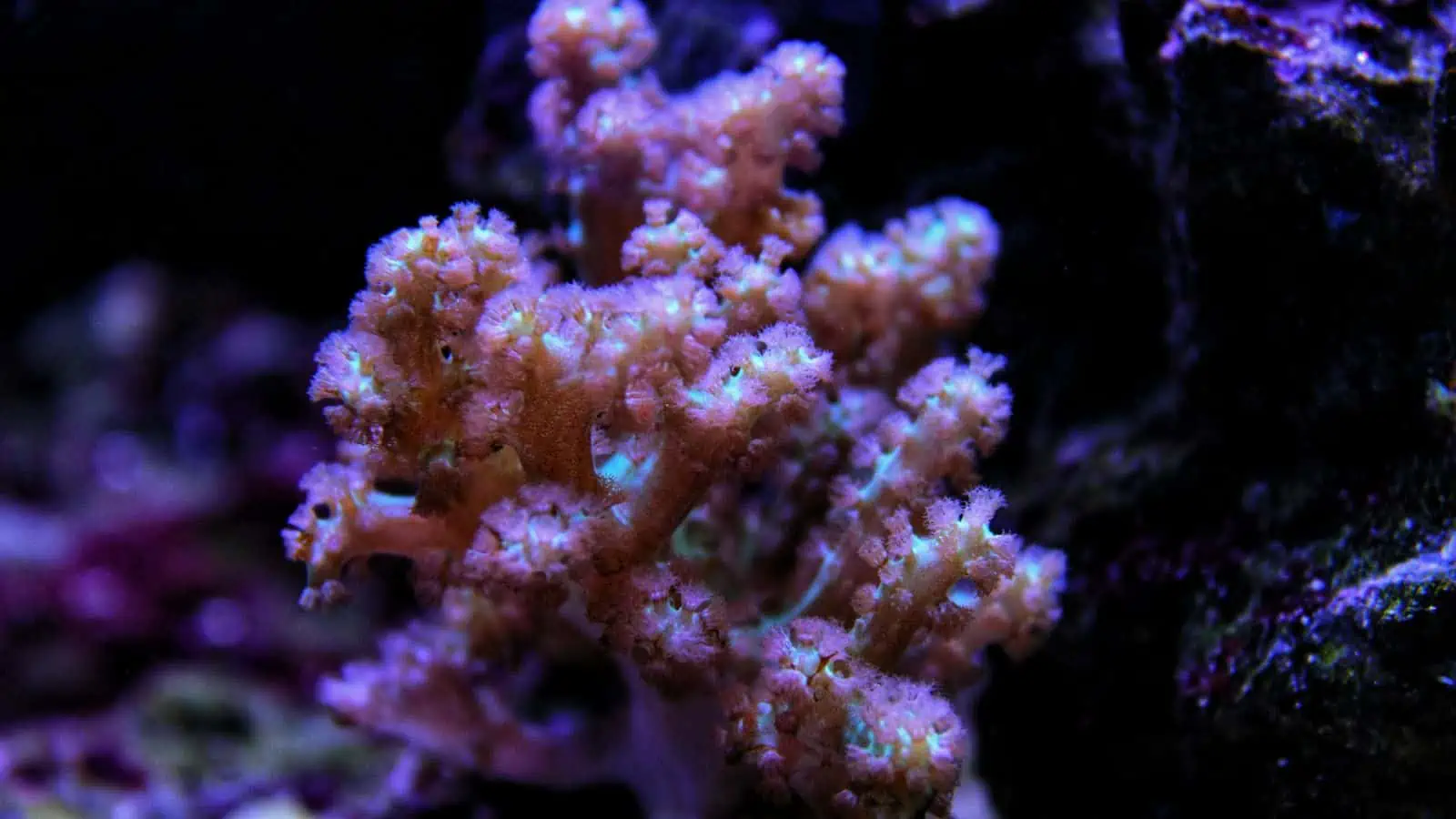
This soft coral’s various names like Kenya tree coral, and ‘Broccoli soft coral’ offer an apt description for these tree-like invertebrates.
Kenya tree coral requires higher light levels than some other soft corals and also enjoys moderate water flow. Because they come from nutrient-rich waters, they also demand better feeding than some other coral types.
Kenya tree corals have a fascinating way of propagating themselves, similar to some terrestrial trees like willows. Dropping their branches to the floor, these pieces will sometimes get washed away and grow into a new colony somewhere else!
Zoanthid and Palythoa Corals

Zoanthids and Palythoa corals are some of the most sought-after coral types by aquarists looking to create an ‘other-worldly’ effect.
This distinct subfamily of soft corals from subtropical and tropical waters is also known as carpet coral, button polyps, “moon polyps”, and “zoas” or “zoos.”
While there are hundreds of color variations, some of the most famous zoas possess psychedelic, luminescent colors that glow, creating a very exotic effect.
A serious consideration to make when growing these corals is the risk factor. Because some species contain a potentially lethal neurotoxin called ‘palytoxin’, it’s extremely important to handle these corals with great care. Eye protection is also necessary when dividing them to protect against blinding squirts in the eye!
Zoanthids can’t survive by photosynthesis alone and also feed on plankton. Meaty foods, such as lancefish, brine shrimp, krill, and bloodworms may also be appreciated.
Toadstool Leather Coral

Toadstool Leather Coral or Mushroom Leather Coral does indeed look remarkably like an underwater mushroom!
It makes this coral another great choice for those looking to give their saltwater aquarium a psychedelic effect, as the cap of the ‘mushroom’ is covered in hundreds of tentacles!
These tentacles vary in length, and the family tends to be divided into ‘short tentacle’ and ‘long tentacle’ types.
Toadstool leather corals prefer low or moderate lighting and moderate water flow. Give this peaceful but vigorous coral plenty of space to grow!
Sinularia Coral

Sinularia corals are a type of soft coral with pale colors and a classic branched form. They are also known as leather corals.
Although they have slightly more specific requirements than some other soft corals, they’re still a good candidate for beginners.
Leather corals are photosynthetic and enjoy moderate-high water flow and lighting, but are quite tolerant of other water parameters. In lower light conditions, you’ll need to supplement them with zooplankton, microplankton, or types of coral food.
When they’re happy, they can grow quite quickly and should be considered a semi-aggressive coral. Because their polyps emit chemicals that can harm other corals, they should be given plenty of space.
Gorgonians – Including Sea Fans

While Gorgonians aren’t the easiest type of coral to keep, they’re a fascinating and significant family of corals, so are worth listing.
Gorgonians are a separate family to either soft or hard corals, and have a leathery skeleton rather than the brittle, rigid skeleton of true hard corals. Some scientists wouldn’t class gorgonians as ‘true coral’ at all, but because they’re still made up of polyps, they’re usually referred to as a coral in the aquarium trade.
One of the most famous groups of gorgonians is the ‘sea fans’ or ‘fan coral’ – extremely beautiful yet a difficult type of coral to maintain. Some sea fans photosynthesize, while others rely on external food sources for sustenance.
Most sea fans need a strong water flow to prevent algae from covering them and to help shed their mucus membranes. As you’ve probably guessed by now, gorgonians are not for beginner reef keepers and should be left to intermediate or expert hobbyists.
Types of Hard Coral
As mentioned at the beginning of the article, hard corals (including ‘stony corals’) tend to be more difficult to keep than soft corals.
Candy Cane Coral

Candy cane corals are large polyp corals (LPS) corals that are one of the best hard corals for beginners.
While other types of LPS can be aggressive, with long stinging tentacles, the candy cane coral has shorter sweeper tentacles and so can be kept closer to other corals without problems.
Also known as ‘trumpet coral’ and ‘bullseye coral’, this attractive species can come in vivid green, yellow, or brown colors that appear to glow brightly under blue light.
Candy cane corals only grow moderately quickly and require moderate light and water currents. Feeding them is a good idea to supplement their photosynthetic metabolism.
Bubble Coral
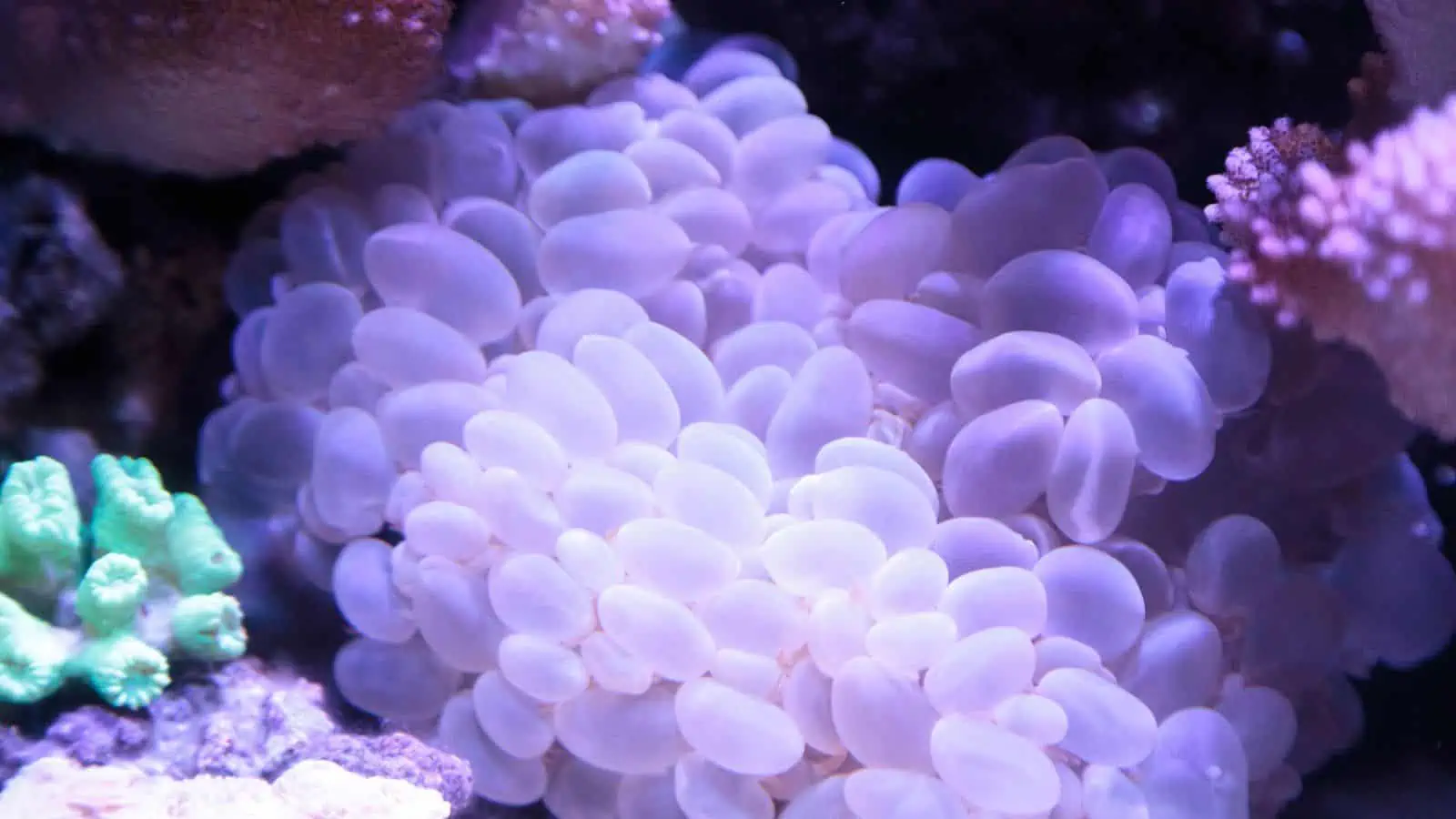
Bubble coral is another fairly robust LPS species, but slightly more difficult to keep than candy cane.
Also known as the Bladder Coral, Grape Coral, or Pearl Coral, Bubble Corals are large corals that come in white, tan, green, blue, gray, and yellow colors. They prefer moderate lighting and a low-moderate water current.
Like many other LPS corals, bubble corals have long sweeper tentacles that sway about at night, damaging other corals anywhere near them with a powerful sting. For this reason, they need plenty of space to avoid damaging other corals nearby.
While they obtain most of their nourishment through photosynthesis, bubble corals grow much more vigorously when supplemented with other small foods such as shrimp.
Lobed Brain Coral

Also known as “Lobo’s’ ‘ or “Lobophyllia’, this LPS is another large and popular coral that can make an eye-catching centerpiece to a reef aquarium.
Lobed brain corals are fairly slow-growing, though, so it can take a while for them to reach an impressive size. Furthermore, there are fairly high fatality rates with young lobed brain coral due to the shipping stress that many of them are still undergoing when you buy them.
Lobed brain corals enjoy moderate to high light levels, but too much light can cause them to bleach. They also have sweeper tentacles that can damage other corals during the night, so need plenty of space in the middle or bottom of the tank.
Lobos are still easier to keep than many other LPS species though, and come in stunning colors including blue, orange, green, red, black, and tan colors.
Pavona Coral

Pavona corals are sometimes known as ‘potato chip corals’ or ‘cactus corals’ because of their beautifully wavy plates that can appear like potato chips or cactus segments.
Pavona is a peaceful and reasonably forgiving SPS species for intermediate reef aquarists who are still perfecting the water quality in their tank.
Members of this genus prefer moderate lighting and a strong water current to clean away the debris that sometimes accumulates on the coral, causing dieback.
Hammer Coral

Hammer corals are so-called because of the hammer head-like tips on their tentacles.
These corals are fairly popular but need slightly more stable water conditions to thrive than the previous species so are best introduced only after you have sufficient experience managing your reef tank.
Hammer corals need moderate lighting and water flow to be happy, and prefer life on the lower edges of the reef. They also need adequate calcium in the water for them to build up and maintain their calcium carbonate skeleton.
Hammer corals are reasonably quick to grow when well-cared for, and need plenty of space to prevent their neighbors being damaged by their aggressive sweeper tentacles.
Coming in green, blue, gold, purple, and gray colors, hammer corals can be very attractive, but should only be attempted by reef aquarists with a reasonable level of experience. Find out more about hammer corals here!
Clove Polyps Coral
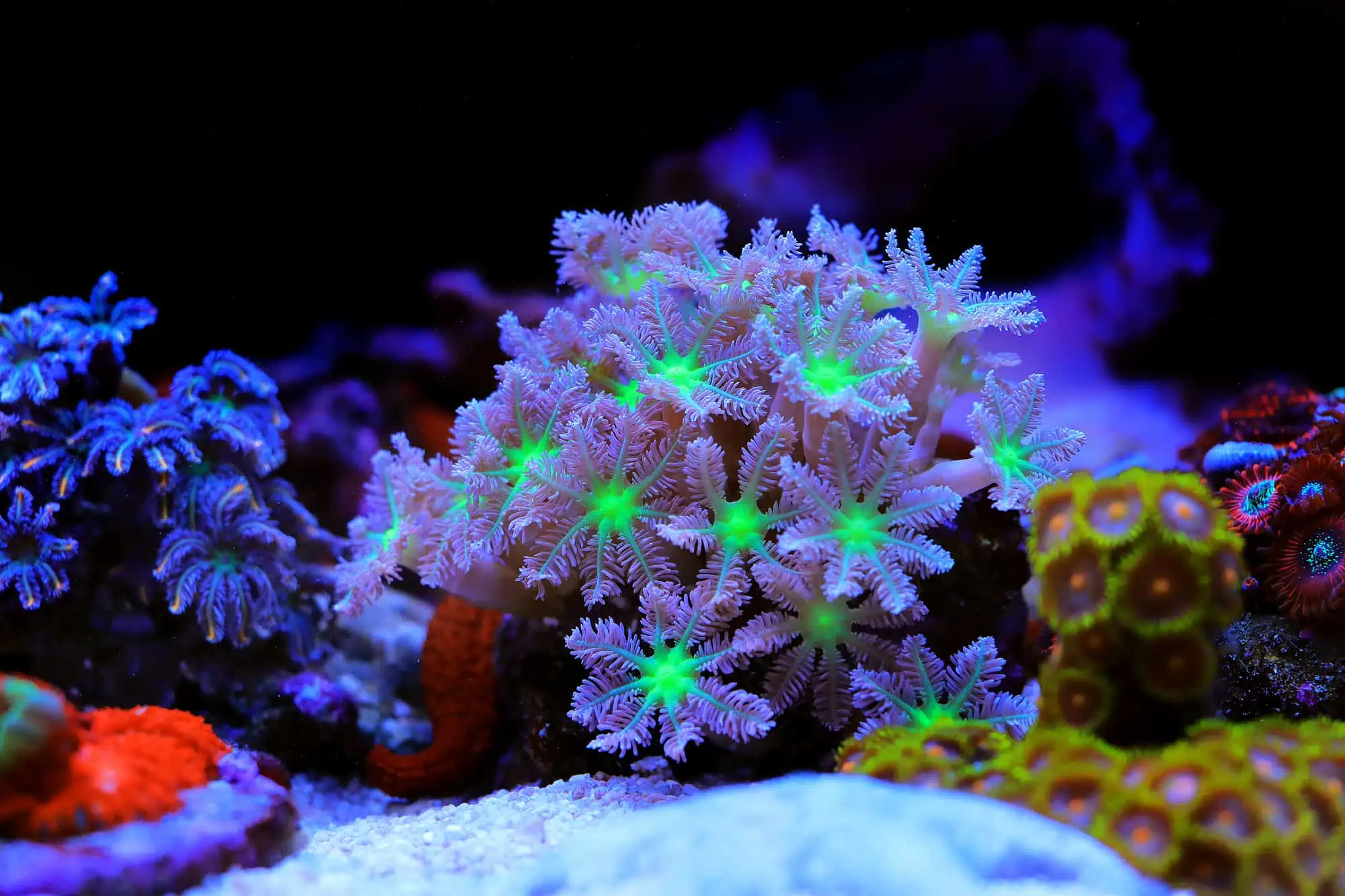
Clove polyps belong to the Octocorallia group of corals – so-called because the polyp ‘legs’ come in multiples of eight.
Clove polyps are extremely popular with beginners and experienced reef tank specialists alike. They’re fairly unfussy and will do well in a wide range of water flow and lighting setups, but a gentle water flow will create attractive rippling motion.
While clove polyps are photosynthetic and reasonably easy to care for, they grow slowly so need to be placed away from more aggressive corals. You can increase their growth rate by offering them additional foods like rotifers, krill, and other live and frozen foods.
Moving Onto Sea Anemones

Most people recognize anemones as distinct from corals, but it’s worth saying here that these fascinating marine animals are far more difficult to keep than most corals.
Although some species of fish, such as clown fish, form a symbiotic relationship with anemones and look stunning with them, most beginner attempts to keep anemones result in the anemones dying prematurely.
Anemones need extremely stable water conditions to survive, meaning they should only be considered for well-established reef setups managed by an experienced reef keeper!
You can read more about anemones for clownfish in our dedicated article here.


